Getting your trailer ready for some serious boondocking usually calls for some type of replenish-able, off-grid power source like adding solar panels and a generator. However, power generation is only 1 part of the formula when considering ways to build up your off-grid power. You will also need to consider ways to increase power storage capacity as well as items to help lower your consumption. The latter two are frequently ignored even though they can be more cost efficient.
(FYI, if you would rather watch my video series on this LED upgrade instead of reading the entire post, click here to skip to the bottom of this post.)
When we installed solar panels on our Airstream, we opted for just a pair of 50-watt panels. 100 watts are not a lot of power for a trailer this size but since we also carry our Honda EU-2000i generator, we thought that it would be sufficient. As you see in the photo above, we still have room to grow if we ever decided to add more panels.
When we took a closer look at how our electrical power is being used, it became clear that the halogen bulbs throughout the Airstream is one of the biggest draws on our battery bank. We have plans to add more internal batteries to our system but that involves running heavy gauge wires and drilling holes for the connections. Instead, we decided to first replace the most often used lights with new and very energy efficient LED lights from LED4RV.com.
We have been doing a lot of research on what types of bulbs to buy and where to get them when our friend Rich did a post on his blog about some of the upgrades he has done. The most difficult part about replacing bulbs to LEDs is that you can never get a good accurate reading on the color temperature of the light and the brightness from someone else’s description. Everyone has a different idea of what they like and since these replacement bulbs are a little on the expensive side, we didn’t want to invest in a complete set of replacements before testing a few first. My hope is that his post will help you with your decision on which LEDs are right for you in your upgrade process.
In our Airstream International Ocean Breeze model, we have ‘puck’ lights inside the hanging cabinets that filter light through the semi transparent doors. We like to use those as they give a nice soft light through out the trailer. We started by just replacing some of them to see how they looked. After the initial installation, we were really impressed with how they compared to the stock halogen bulbs. Not only are the colors a good match, they are just as bright as compared to the halogens. The best part is they use less than 1/8 the power per light so now we can light the entire Airstream without pegging the meter on our electrical system. After the successful test, we decided to order a complete set of replacements.
The lights we opted to replace are all of the puck lights in and under the cabinets. The rest of them are located on the ceiling that run the entire length of the trailer and we decided to keep them original. We hardly ever used them so it was not worth the extra expense. There are a total of 27 puck lights in our trailer and we replaced 15 of them at the cost of $14.95 per bulb. That is about 5 times the price of a replacement halogen bulb but with a lifespan of 5,000 hours, they will more than pay for themselves in maintenance costs alone.
If you have never replaced these bulbs, you will know that it is very easy. The lenses of the puck lights pop right off as they are only held on by spring pressure. I used a butter knife to wedge into the edge of the lens frame and with just a couple of nudges, it comes off. The LEDs drop right into the same G4 connectors and within a few seconds, you are done. I did all 15 lamps in under 10 minutes.
Some of the other lights that can be replaced are the wall-mounted sconces, the bathroom and shower lights and the pivoting reading lights. LED4RV.com has all of the bulbs depending on what connection you need for each unit. Aside from the G4 lights in the pucks, I had T-10 lights in my wall sconces and 1154-type terminals in my bathroom lights.
The original bathroom lights are standard incandescent 1154 bulbs. There are no reflectors in these fixtures so the owner of LED4RV, Dan Brown, recommended that I use a pad-style light in these fixtures. Dan is extremely helpful as he knows that people have very particular preferences in their lighting requirements so if you have questions about which ones you should order, he will be happy to help you with as he did for me.
Here are the LED pads inside one of the bathroom fixtures.
I am very happy with how they turned out. Marlene likes to have all 4 of these lights on when she is getting dolled up in there. Now I don’t have to worry about her killing our batteries.
The last bulb we had replaced in the Airstream was the reading light that is mounted directly over the queen bed. We used it at night all the time as general purpose lighting. The replacement is also the same 12-LED Warm white G4 style bulb like the puck lights with just a different configuration of the terminals to fit in this fixture. It is very bright and what we like to do is point it at the bulkhead next to our bed so it can reflect light to the rest of the bedroom.
The benefits of upgrading to LEDs in the trailer is more than just lowering your electrical consumption. It also significantly lowers your maintenance costs by not having to replace them regularly as they burn out. With a 5,000 hour lifespan, even if you used every light 4 hours a night, they will run for 1,250 nights. Unless you are a full timer, most people probably spend less than 100 nights per year in their RV. That means these bulbs will last more than 12.5 years if they lives up to the manufacturer’s claims. Another significant benefit is the reduction of heat that is produced by the halogen bulbs. Each one of the factory puck lights is effectively a 10-watt electrical heater. When all 28 of them are on, it is equivalent to running a 280-watt heater that your A/C unit has to fight against when cooling down the air during these hot summer nights we have been having recently.
In all, we replaced 23 lights from halogen and incandescent to LED inside the Airstream. Here are the links and price breakdowns on them for you to consider:
- 15 x 12-LED Warm White G4 Chip @ $14.95 per Chip = $224.25
- 5 x Large Warm White Pad 1156 @ $19.95 per pad = $99.75
- 2 x Warm White 13-LED T10 socket @ $12.95 per Chip = $25.90
- 1 x 12-LED Warm White Reading Spot @ $15.95 per Chip = $15.95
The total cost of an upgrade like this will run you $365.85. We did not have to pay sales tax and shipping is free for orders over $30. That is a relatively costly upgrade if you are someone who just uses their trailer infrequently on weekends and holidays. But if you are spending any extended amount of time in your RV, or if you plan on dry-camping and boondocking at all, it is very cost effective when you compare it to the cost of buying and installing a solar system or a generator. It is a simple DIY project that will make an immediate difference. As many of you know, some of the best camping you can do in the world are in places where 30-amp plugs and concrete pads are nowhere to be found.
If you are interested in trying out LED upgrades in your RV, my recommendation is for you to figure out which lights are most often used and start by replacing those. Just by replacing 4 puck lights in your trailer, you will have plenty of general purpose lighting while using only half as much energy as a single halogen bulb with only a $60 investment.
I hope this post has been helpful for those of you contemplating a LED upgrade. Please watch the video series I have put together on YouTube (Part 1 of 4 is embedd below.) and subscribe to our channel for more how-tos, upgrades and videos of our adventures.
over and out,
dan
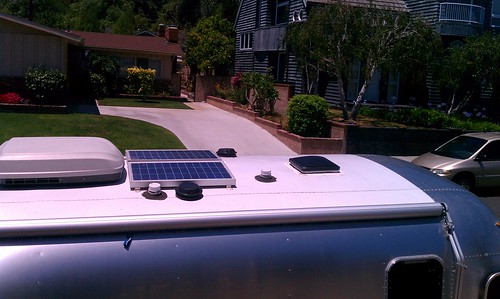
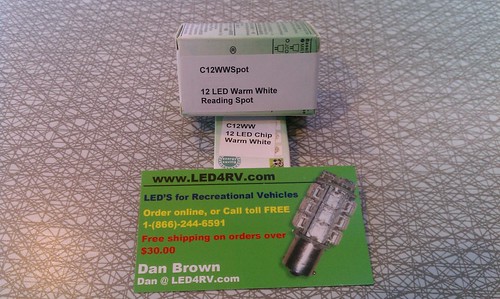

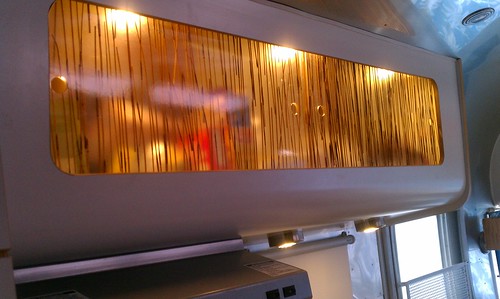
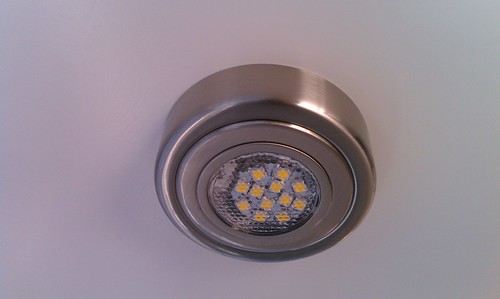

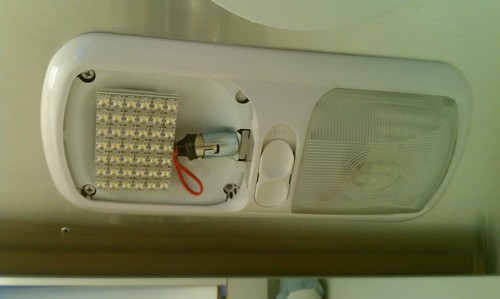

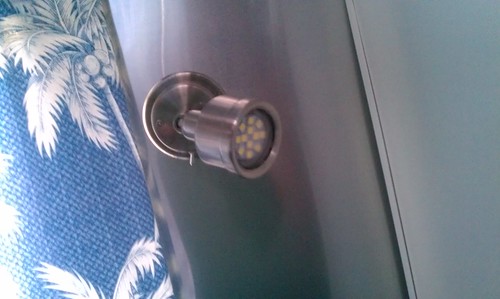
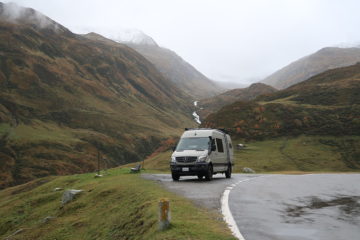


7 Comments
jerry · July 18, 2012 at 7:36 am
Thanks Dan,
I will eventually replace my old lights as they burn out. Since I only boon dock en route to my next plug in site, it isn’t a big issue.
But the heat savings does appeal to me, as I had eight people in my ’19 Bambi in 100 degree weather, the AC did struggle a bit.
I had to pull out my little tabletop fan, because I was cooking a meal as well.
dan · July 18, 2012 at 11:14 am
Hi Jerry, 8 people in a 19 ft Bambi and cooking at the same time? That is a full house! We typically only boondock too when we are en route at a walmart or truck stop. But now we have solar panels and LED lights, we are going to be doing a lot more of it. I was always envious of people who didn’t need to be tethered. I think replacing them as you go is a good idea. I would recommend doing all of the ones in the same circuit. That’s usually 2 or 3 of them. It will give you the option of using only LEDs when boondocking to save power.
Susan · July 22, 2012 at 2:17 pm
Dan –
Great post! Really appreciate all the information. See you “in the ‘stream”!
Michael Smith · August 20, 2012 at 4:20 pm
Thanks for this article. I have an 07 25ft FB. I tried earlier LED versions four years ago and my wife found them to be too dull and yellow (warm white 9 LED) or too bright and blue (bright whites). She preferred (insisted) on keeping the halogens.
Now it seems the choices are much better and I’m ready to try it again.
Alphonse · August 28, 2012 at 6:23 am
Dan,
Thanks for putting together this documentary on your LED conversions, very well done! It is informative and provided insights that are quite useful. My primary objective for LEDs in my AS is to eliminate the heat of the incandescent and halogen bulbs. I may do the whole monty in my 28 footer but will do a test to get the colors right.
Safe travels . . . .
Liam on Maui · July 12, 2014 at 3:00 pm
Awesome! I love the internet and I thank you for basically completely assisting me in my mental process of whether or not to upgrade to LED. I’m loving the warm white. I will def give Dan the business at LED4RV.com. Aloha from Maui – Liam
dave · August 2, 2018 at 11:25 am
We have an ’88 34 foot Airstream that was suffering from lack of light. The overhead fluorescent fixture just wasn’t cutting it. We added 6 LEDs by way of a custom enclosure and it worked out great for us: https://trav.elish.net/blog/airstream-led-ceiling-lights